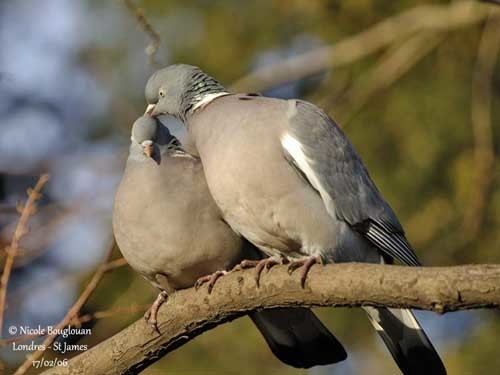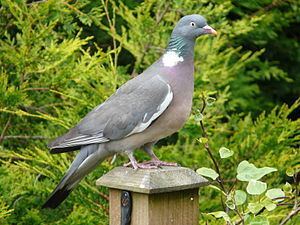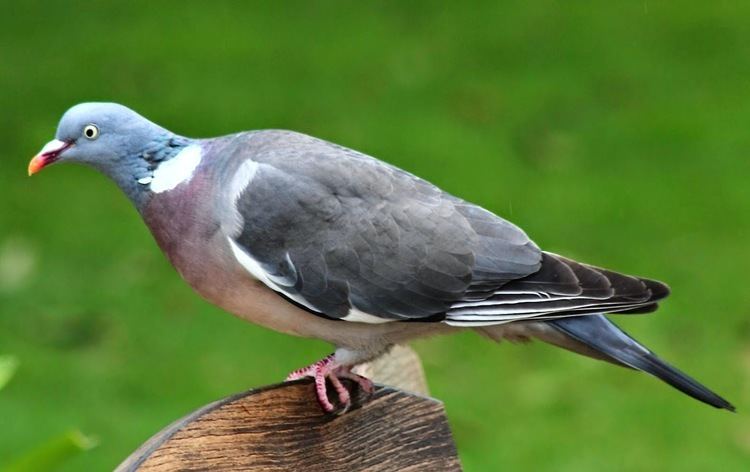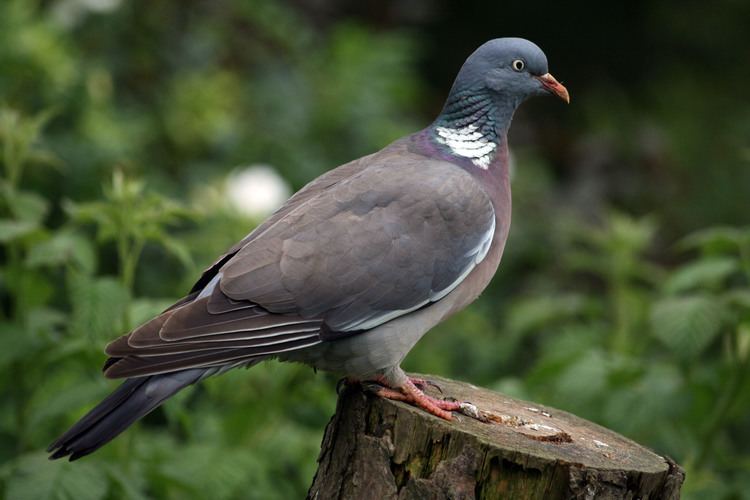Order Columbiformes Genus Columba Mass 490 g Rank Species | Phylum Chordata Scientific name Columba palumbus Higher classification Columba | |
 | ||
Conservation status Least Concern (Population increasing) Similar Bird, Pigeons and doves, Eurasian collared dove, European turtle dove, Stock dove | ||
Mes ramiers common wood pigeon
The common wood pigeon (Columba palumbus) is a large species in the dove and pigeon family. It belongs to the Columba genus and, like all pigeons and doves, belongs to the family Columbidae. It is locally known in southeast England as the "culver"; This name has given rise to several areas known for keeping pigeons to be named after it, such as Culver Down.
Contents
The genus name Columba is the Latin word meaning "pigeon, dove", whose older etymology comes from the Ancient Greek κόλυμβος (kolumbos), "a diver", from κολυμβάω (kolumbao), "dive, plunge headlong, swim". Aristophanes (Birds, 304) and others use the word κολυμβίς (kolumbis), "diver", for the name of the bird, because of its swimming motion in the air. The specific epithet palumbus is derived from the Latin palumbes, "wood pigeon".

Distribution

In the colder northern and eastern parts of its Europe and western Asia range the common wood pigeon is a migrant, but in southern and western Europe it is a well distributed and often abundant resident.
Description

The three Western European Columba pigeons, common wood pigeon, stock dove, and rock pigeon, though superficially alike, have very distinctive characteristics; the common wood pigeon may be identified at once by its larger size at 38–44.5 cm (15.0–17.5 in) and 300–615 g (10.6–21.7 oz), and the white on its neck and wing. It is otherwise a basically grey bird, with a pinkish breast. The wingspan can range from 68 to 80 cm (27 to 31 in) and the wing chord measures 24 to 25.4 cm (9.4 to 10.0 in). The tail measures 13.8 to 15 cm (5.4 to 5.9 in), the bill is 1.9 to 2.2 cm (0.75 to 0.87 in) and the tarsus is 2.5 to 2.8 cm (0.98 to 1.10 in). Adult birds bear a series of green and white patches on their necks, and a pink patch on their chest.

Juvenile birds do not have the white patches on either side of the neck. When they are about six months old (about three months out of the nest) they gain small white patches on both sides of the neck, which gradually enlarge until they are fully formed when the bird is about 6–8 months old (approx. ages only). Juvenile birds also have a greyer beak and an overall lighter grey appearance than adult birds.
Behaviour
Its flight is quick, performed by regular beats, with an occasional sharp flick of the wings, characteristic of pigeons in general. It takes off with a loud clattering. It perches well, and in its nuptial display walks along a horizontal branch with swelled neck, lowered wings, and fanned tail. During the display flight the bird climbs, the wings are smartly cracked like a whiplash, and the bird glides down on stiff wings. The common wood pigeon is gregarious, often forming very large flocks outside the breeding season. Like many species of pigeon, wood pigeons take advantage of trees and buildings to gain a vantage point over the surrounding area, and their distinctive call means that they are usually heard before they are seen.
Breeding
It breeds in trees in woods, parks and gardens, laying two white eggs in a simple stick nest which hatch after 17 to 19 days. Wood pigeons seem to have a preference for trees near roadways and rivers. Males exhibit aggressive behaviour towards each other during the breeding season by jumping and flapping wings at each other. Their plumage becomes much darker, especially the head, during hot summer periods.
The nests are vulnerable to attack, particularly by crows, because they live in the countryside, the more so early in the year when the leaf cover is not fully formed. The young usually fly at 33 to 34 days; however, if the nest is disturbed, some young may be able to survive having left the nest as early as 20 days from hatching.
Diet
Most of its diet is vegetable, round and fleshy leaves from Caryophyllaceae, Asteraceae, and cruciferous vegetables taken from open fields or gardens and lawns; young shoots and seedlings are favoured, and it will take grain, pine nuts, and certain fruits and berries. In the autumn they also eat figs and acorns, and in winter buds of trees and bushes. They will also eat larvae, ants, and small worms. They need open water to drink and bathe in. This species can be an agricultural pest, and it is often shot, being a legal quarry species in most European countries. It is wary in rural areas, but often quite tame where it is not persecuted. Young common wood pigeons swiftly become fat, as a result of the crop milk they are fed by their parents. This is an extremely rich, sweet fluid that is produced in the adult birds' crops during the breeding season.
Call
The call is a characteristic cooing.
